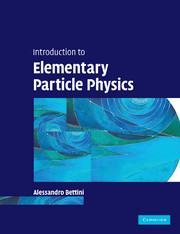Book contents
- Frontmatter
- Contents
- Preface
- Acknowledgments
- 1 Preliminary notions
- 2 Nucleons, leptons and bosons
- 3 Symmetries
- 4 Hadrons
- 5 Quantum electrodynamics
- 6 Chromodynamics
- 7 Weak interactions
- 8 The neutral K and B mesons and CP violation
- 9 The Standard Model
- 10 Beyond the Standard Model
- Appendix 1 Greek alphabet
- Appendix 2 Fundamental constants
- Appendix 3 Properties of elementary particles
- Appendix 4 Clebsch–Gordan coefficients
- Appendix 5 Spherical harmonics and d-functions
- Appendix 6 Experimental and theoretical discoveries in particle physics
- Solutions
- References
- Index
- References
4 - Hadrons
Published online by Cambridge University Press: 05 June 2012
- Frontmatter
- Contents
- Preface
- Acknowledgments
- 1 Preliminary notions
- 2 Nucleons, leptons and bosons
- 3 Symmetries
- 4 Hadrons
- 5 Quantum electrodynamics
- 6 Chromodynamics
- 7 Weak interactions
- 8 The neutral K and B mesons and CP violation
- 9 The Standard Model
- 10 Beyond the Standard Model
- Appendix 1 Greek alphabet
- Appendix 2 Fundamental constants
- Appendix 3 Properties of elementary particles
- Appendix 4 Clebsch–Gordan coefficients
- Appendix 5 Spherical harmonics and d-functions
- Appendix 6 Experimental and theoretical discoveries in particle physics
- Solutions
- References
- Index
- References
Summary
Resonances
The particles we have discussed up to now are metastable, in other words they decay by weak or electromagnetic interactions. The distances between their production and decay points or between the corresponding times are long enough to be separately observable.
If the mass of a hadron is large enough, final states that can be reached by strong interaction, i.e. without violating any selection rule, become accessible to its decay. Therefore, they have extremely short lifetimes, of the order of 10−24 seconds, and decay, from the point of view of an observer, exactly where they were born. To fix the orders of magnitude, consider such a particle produced in the laboratory reference frame with a Lorentz factor as large as γ = 300. In a lifetime, it will travel one femtometre.
These extremely unstable hadrons can be observed as ‘resonances’ in two basic ways: in the process of ‘formation’ as a local maximum in the energy dependence of a cross section or in the ‘production’ process as a maximum in the (invariant) mass distribution of a few particles in the final states of a reaction.
Resonant phenomena are ubiquitous in physics, both at the macroscopic and microscopic levels. Even in very different physical situations, ranging from mechanics to electrodynamics, from acoustics to optics, from atomic to nuclear physics, etc., the fundamental characteristics of this phenomenon are the same. Actually, the classical and the quantum formalisms are also very similar. Resonances have an extremely important role in hadron spectroscopy.
- Type
- Chapter
- Information
- Introduction to Elementary Particle Physics , pp. 109 - 163Publisher: Cambridge University PressPrint publication year: 2008



